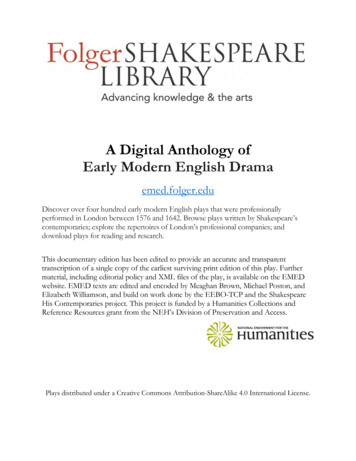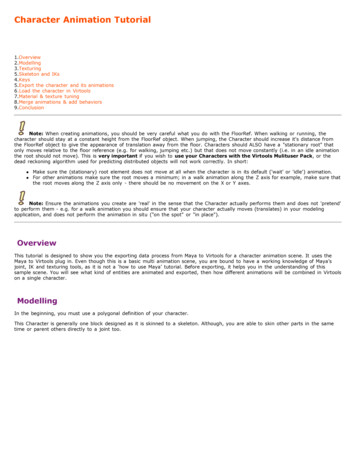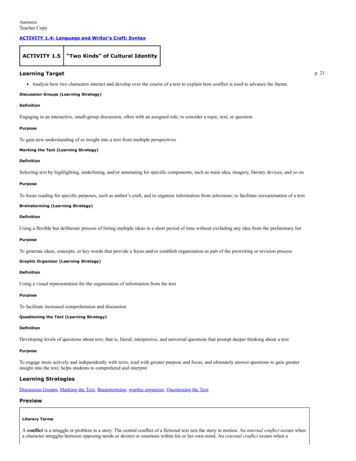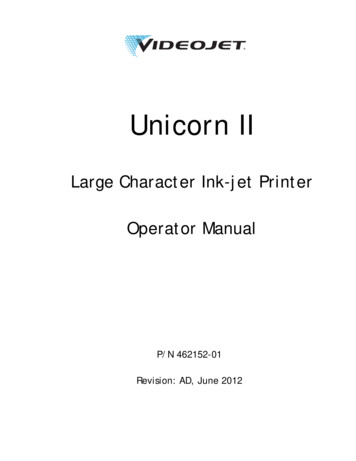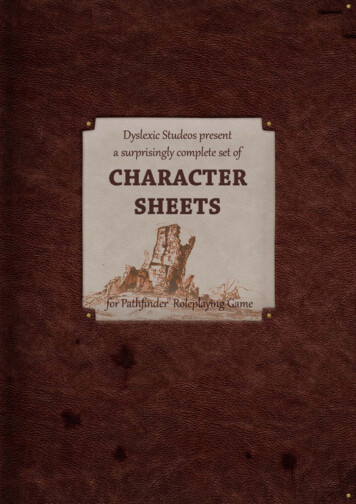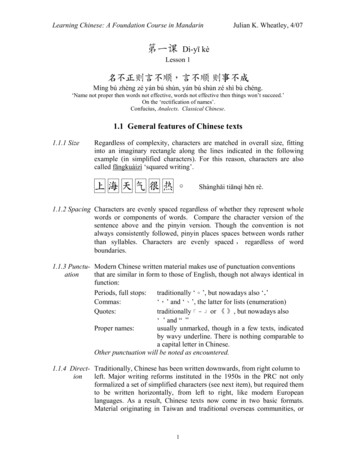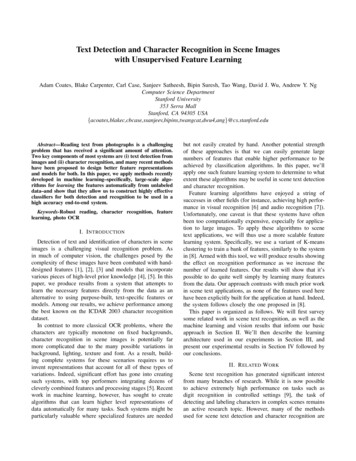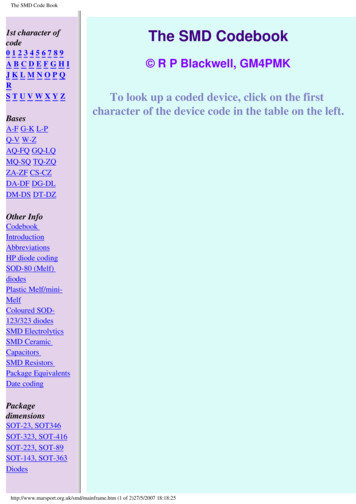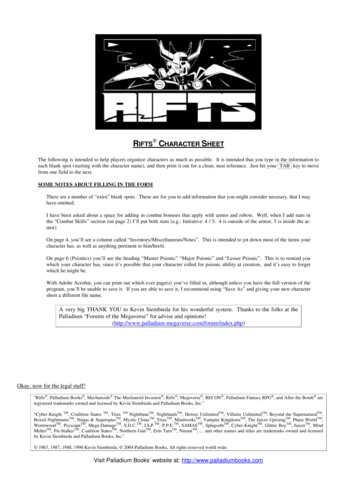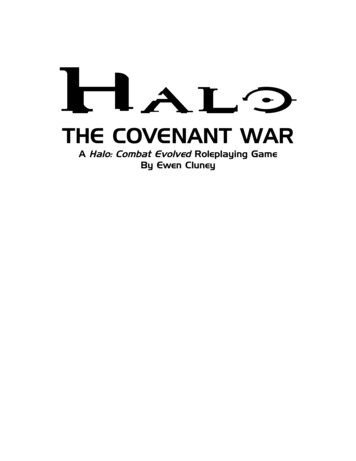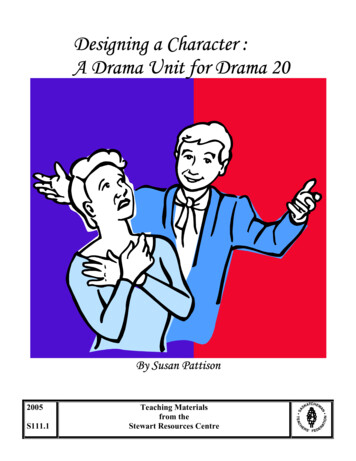
Transcription
Designing a Character :A Drama Unit for Drama 20By Susan Pattison2005S111.1Teaching Materialsfrom theStewart Resources Centre
Table of ContentsIntroductionp. 1Key to CELSp. 1Foundational Objectivesp. 1Concept Mapp. 3ActivitiesOne:Two:Three:Four:Five :Six:Seven:Eight:Nine :Ten:Imagining CharacterCharacter CollageDeveloping Back StoryCharacter HistoryRelationshipsObjectivesCharacters in ConflictBringing in the Character’s PastDisplaying the CharacterWriting and Presenting a Character Monologue¾ Monologue Rubricp. 4p. 6p. 7p. 9p. 12p. 14p. 16p. 19p. 21p. 23p. 25Final Assessment Tallyp. 26Annotated Website Bibliographyp. 27Bibliography of Print Sourcesp. 28Appendix A: Notes on Using Monologues in Collective Creation p. 292
IntroductionDeveloping and Presenting a CharacterThe focus of this unit will be on character development, either in context of a collective creation, or as a discrete section in adrama course.Although the Foundational Objectives for Drama 20 are used as the guidelines for this unit, this unit could also be adapted foruse in Grade 9 or in Drama 10 or 30.Key to CELSCOM communicationPSVS personal and social values and skillsCCT creative and critical thinkingIL independent learningTL technological literacyNUM numeracyFoundational Objectives: page numbers refer to Saskatchewan Education (1993). Drama 10, 20, 30: CurriculumRequirements.1. Develop self-confidence, self-discipline and self-motivation. (COM) (p. 29) Concentrate during drama experiences. (CCT, COM) Develop a sense of responsibility to other members of the class. (PSVS) Cooperate with others. (PSVS)2. Develop an understanding of the processes and elements involved in creating works of dramatic art. (IL, COM) (p. 31) Understand how improvisations can be used to explore characters. (CCT) Create characters from various stimuli (CCT) Understand what motivates the characters they portray. (PSVS) Maintain focus in improvisations. (CCT) Introduce tension to improvisations (CCT) Use contrast in improvisations (CCT)1
Inject the use of symbol into improvisations (CCT, PSVS)3. Develop acting skills. (CCT, COM) (p. 32)2 Portray characters in monologues, improvisations and scripted scenes. (CCT, COM) Express themselves confidently through movement and gesture (COM) Communicate character through movement and gesture. (COM) Participate in blocking (adding movement ) to improvised or scripted scenes (CCT, IL) Understand and execute stage movement effectively (CCT, IL) Understand and execute stage business effectively (CCT, IL) Develop a poised, controlled posture. (COM)
CONCEPT MAPMEMORABILIALIMITSPASTSENSE UE3
Beginnings:Please consult page 26 in the Drama 10, 20, 30 document from Saskatchewan Learning for guidelines in setting up yourclassroom.Activity One: Imagining Character In advance of the class, go through magazines and choose interesting faces of people. You can also use the Art Imagekits (especially the one on portraiture) to find some images of people. Mount the photos you have found on construction paper and place them on the walls all over the classroom. When the students arrive for class, have them sit comfortably and brainstorm some characteristics of characters. Usinga cartoon character such as Homer Simpson can sometimes help the students focus on the characteristics of a character.Generate a list which contains such words as: gestures, characteristic phrases and tone of voice; movement. Thestudents may generate other terms which can be grouped into these general categories. Have the students volunteer to imitate characters that they know from the media. Have the rest of the students guessthe character and help the performing student improve on their depiction of the character. Draw the students' attention to the photographs on the walls of the classroom. Emphasize that without telling anyonewhich image they have chosen they will improvise one of the characters using the generated list of terms. Emphasizethat they will need to develop characteristics from the list. After about five minutes (or so) have the students return to the circle. Ask for volunteers for performance and thenhave the other students guess which person the student is representing. You or the students may question the choicesthat the students have made in representing their characters. Emphasize that any suggestions must be made in apositive way. In their drama journals, have the students write down the generated list of words and comment on the success/failureof the activity. Have them comment on the challenges they had when trying to assume an unknown role based on aphotograph.ASSESSMENTIn your teacher notes, record which students were successful in completing the exerciseand which found it challenging. You could also note which of the photographs were themost useful to use in another year.4
Checklist for Imagining Character:Student Name:Foundational Objective: Develop an understanding of the processes and elements involved in creating worksof dramatic art.Learning Objectives:1.Create characters from various stimuli.1 2 3 452.Understand how improvisation can be used to explore characters.1 2 3 4 5Foundational Objective: Develop self-confidence, self-discipline and self-motivation.Learning Objectives:1.Follow classroom routines and procedures.1 2 3 4 52.Concentrate during drama experiences.1 2 3 4 53.Volunteer to start or join activities.1 2 3 4 55
Activity Two: Character collageMaterials: Newspapers, magazines, construction paper, scissors, glueProcedure: Recap what was accomplished last day. Review the list of character words. Ask the students how they perceived theexercise. Explain to the students that today they will be looking through magazines to find their own character. On thechalkboard, write the following list of instructions:o Your character cannot be an imitation of a movie star, television character or other famous person.o The photograph you choose doesn't have to look like you.o The photograph you choose should give you some idea of the type of person who may be represented.o You will use the construction paper to mount the photograph of the person along with photos of some of theperson's favourite things, expressions, places, etc. Make sure you have given yourself a name.o At the end of the class, you will speak as your character and explain why the symbols, THINGS you havechosen are important to you.o You will be working with this character for more than one class, so plan carefully! Give the students about 20 minutes to find the information that they need. After the collages are completed, have the students form a circle and present the information about their character.Encourage the observing students to ask questions of the character.ASSESSMENTIn their drama journals, have the students comment on their character. They could make a brief character sketch similar tothose done in English class.Check for the completeness of each character collage. Comment anecdotally on the quality of the work, the willingness tosustain character, and the commitment of the student to the exercise.6
Activity Three: Developing Back storyA back story is the sum total of all the events of a person's life which help to form character. It gives the character motivation,and often gives viewers the explanation for a character's actions.Some simple examples of back story events could be: a serious illness the loss of a member of the family a horrendous camping trip being frightened by an animal or reptile and becoming phobicBack story is what gives the character depth and helps make the character believable.Materials: Collages from last day's lesson. Drama journal Traumatic event worksheetProcedure: Recap what was accomplished last day. Discuss the character collages the students have made. Ask one student tovolunteer to explain the significance of one of the items on the collage. Ask probing questions. You will need to getpast “My character just likes cats” type of questions into deeper meanings. Explain the concept of back story. If possible, use examples from your own life. Break the students into pairs. Have them discuss the back stories of one of their favourite TV or movie characters.Give them chart paper to make notes about the back stories of the character. On the chart paper, have them also makenotes about how they found out about the character's back story.o When the students have finished their charts, hand them up in the room and discuss the common themes.Generate a list which contains such terms as: flashback – when an event from the past is shown to the viewers narration – when a character or another character explains the events of the past actions – where the character's actions gives you a clue about the past of the character.7
props – where something the character has or uses gives an insight into the past. reactions – when something another character does causes the character to react in a certain way.Have the students examine their character collages. Have the students choose one item which they could use as part of theirback story. Give them a few minutes to compose their thoughts and have them speak in character to explain the significance ofthis item to their back story.ASSESSMENTIn their drama journals, have the students write out the oral presentation they gave about their character collage object. (Seeassessment guide below.)Make sure that the students have the notes on back story.Check for the completion of the student writing:Format for Journal Entry: Back StoryName of Character:Object from character collage:Make sure you have answered the following questions in the text of your journal entry:8 Why did you choose this item? Where does it fit into your past? How would you feel if it was lost or stolen? When you use this item, what physical movements do you do? What type of emotional reactions does this item give you? Why?
Activity Four: Character historyA character history is a tool used by actors to examine a part. The use of a history helps fill in theholes of a character's life and often leads to further exploration of the character.Materials: Character history sheets Character collages Drama journalProcedure: Have the students review what they have written about their character in their dramajournals. Explain to the students that they will be working in role during this exercise. Explain the rules of the Dating Gameo One student will be the person who is searching for a date. That person will askquestions to determine which of the characters is most appropriate for a date for himor her.o Three other students will act as contestants on the dating show. Each contestantwill try to secure a date with the person who is looking for a date. Every answerthey give to the questions from the contestant must come from some aspect of thecharacter they have designed.o The observers in the classroom will take notes on the contestants' ability to stay inrole during the game. At the end of each round of the game, students will share theircomments about what they have observed.It is important to keep this game moving. Try to allow no more than three questions for each person.Go through the whole class until everyone has had a chance to participate.9
After the game, have the students discuss the commitment to character using the notes that they have taken. What more didthey learn about the characters their classmates have devised? Where were there gaps in the character information?Give the students the notes on character history. Discuss character history in regard to their personal history.Hand out the character history sheets and have each student complete one for the character he/she has devised.ASSESSMENTHave the students complete the character history sheet and put it in their drama journals.Check for the completion of the sheets.10
Name:Character Name:Personal Hobbies:Least favorite foods:Favorite beverages:Least favorite beverages:Favorite dessert:Favorite country: Why?Favorite color:Favorite restaurant:Favorite school subject:Boy/Girlfriend:Favorite relative: Why?Best friend:Favorite movie/play/musicalMusic/art/poetry preferencesWhat do you like to wear?Worst enemy:Favorite book:Height: Weight: Age:Religion:Occupation:Awards received:Previous employment:Most embarrassing moment:11
Activity Five: RelationshipsIn drama, as in real life, people have various relationships. These relationships may be close, such asfamily and close friends, or more distant such as teachers, co-workers, etc. Every type of relationshipfollows certain rules. What you can or cannot do in a relationship depends on the closeness and trustwithin the relationship.In relationships, actors pay attention to movement, voice, and diction. These three aspects ofcharacter vary according to whom the character is addressing.Materials:Two telephones (or reasonable facsimiles)Drama journalsCharacter collages and history sheetsProcedure:12 Ask the students what kind of phone calls they received last night. Write down the results onthe chalk board. Ask the students to carefully examine the list and see if they could add more types of calls.You should get a list which may contain:parentsfriendspizza guytelemarketerlibrary Ask the students to brainstorm some more types of calls. Some ideas are:principal of the schoolhomeroom teacherspoliceparent's boss Ask for two volunteers. Put one volunteer at each phone. Have one person phone the otherand have a telephone conversation. You may have to model this. The person who telephonesmay be anyone (perhaps one from the list) but the person who answers the phone must be intheir character. Have the observing students look for commitment to role. When the exercise is completed, give the students the notes on relationships. As
o Your character cannot be an imitation of a movie star, television character or other famous person. o The photograph you choose doesn't have to look like you. o The photograph you choose should give you some idea of the type of person who may be represented. o You will use the construction paper to mount the photograph of the person along with photos of some of the person's favourite things .File Size: 375KBPage Count: 35
